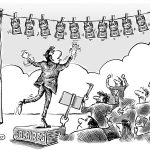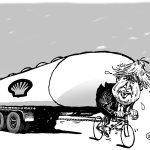Putting cities in the countryside
Pandemic, confinement … Big cities are no longer popular, and new technologies could provide some workers with the means to escape it.
” Cities must be put in the countryside, the air is healthier,” said already a comedian in the middle of the XIXth century1. As the confinement is lifted, the aspiration has just found new impetus. No more cramped apartments, overcrowded public transportations, open spaces, skyscrappers and business districts! Long live remote work, work-life balance, the great outdoors and open roads. Polls show that the risk of a pandemic has been added to the already long list of inconveniences in the city and contributes with pollution, housing prices and the cost of living, to push city dwellers out of the big cities, seeking a house with its green corner.
Does this sound the death knell for the big cities? Some people already fear the start of a new decline, marked by the flight of economic activities, the middle classes and an even more marked social fragmentation between neglected areas and rich neighborhoods. In the meantime, the risk is to see the headquarters of large groups leave cities or at least reduce their areas of activity; a direct threat to local finances.We think of New York in the 1970s, before its rebirth 20 years later.
If you’re ready to move,it’s not quite anywhere.
The fate is not entirely cast for all that.The experience of confinement also served to reveal that city centers remain an essential point of attraction and rallying. The young ultra-connected generation enjoys meeting there for both work and leisure. It is possible that the world of finance, which until now occupied the upper hand but which has learned to organize itself in remote work, relocates and is replaced by the new economy. Thus one industry would drive out the other, as was the case before with the world of factories and workshops, when they exited big city centers. For the city, the stakes are high because it involves reinventing mobility. With overloaded public transport, travelers will prefer to space their journeys, or choose other means of transportation… The trend was already well advanced in Europe, the historic centers are closed to cars, in favor of the development of cycle paths. The one or two wheels – preferably electric – are taking the ascendancy. From this point of view, cities must take up the challenge of a new attractiveness, and an investment program in communication, equipment and infrastructures.
The stakes are no less for the “province”. Because if many are ready to move, it is not quite anywhere. Take the example of France. Except perhaps the collapsologists, the candidates for “return to the earth” are not ready to give up their way of life. The destinations in view this time would rather be small or medium-sized agglomerations, far from the already overcrowded seaside cities, in the periphery of certain large regional cities or even very well connected to Paris by road or speed train. Next to the already popular Orléans and Tours, there are Montauban, Limoges, Le Mans, Arras, Quimper, Poitiers and Angoulême. In short, cities large enough to have the necessary public facilities and services (schools, hospitals) and I would dare say even more well equipped with high speed internet! These cities, whose population has stagnated or almost stagnated for many years, could therefore experience a new boom, their challenge remaining that of the development of their territory and investments in adequate equipment. France has just announced the launch in September of a new auction tranche for the allocation of 5G frequency blocks, with commitments to cover the whol territory.
If the city goes to the countryside, will the countryside come to town?
Will the countryside welcome these newcomers with open arms? This is not so sure. The examples of difficult cohabitations multiply, from court trials against singing roosters or church bells to the requirements of withdrawal of spreading of fields because of proximity to new housing lots, grievances abound on the side of the countryside, which has seen its territory cropped by the expansion of large metropolises.
For their part, the big cities are reinventing themselves: beehives on the roofs and honey from the Paris Opera await you, mushroom farms are back in cray caves, and collective gardens grow on the terraces, while building walls are planted again. If the city goes to the countryside, will the countryside come to town? The images of our deserted urban centers, involuntarily returned to sometimes the most unexpected animals, could make us believe it.
These eminently French examples will also find their meaning elsewhere in Europe. While less “centralized”, countries like Germany, Switzerland or Italy are likely to follow similar trends. It is less easy to decide for the United States or Asia where other parameters are to be taken into account.
The pandemic and the “great confinement” should in any case reshuffle the cards of a real estate market whose speculative surges may have been broken.
1Attributed to Alphonse Allais, the expression is by Jean Louis Auguste Commerson, in his buffoon’s encyclopedia published in 1860.



